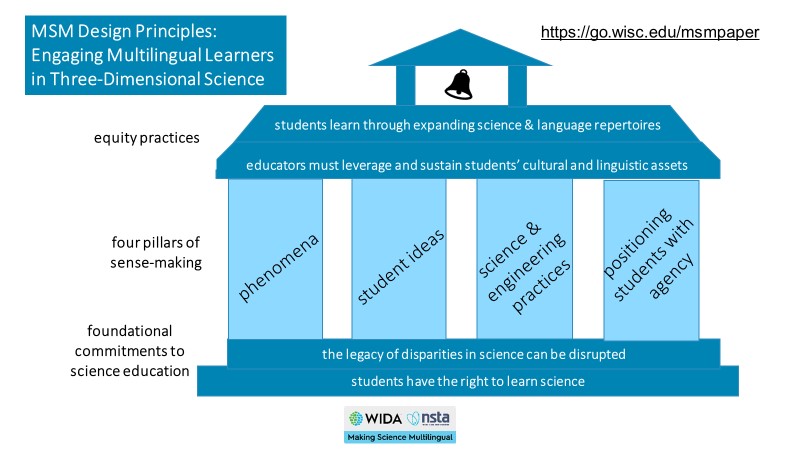Next Gen Navigator
Designing Equitable Engagement in Sensemaking
By David T. Crowther, Lynn M. Jeka and Rita MacDonald
Posted on 2020-12-17
Disclaimer: The views expressed in this blog post are those of the author(s) and do not necessarily reflect the official position of the National Science Teaching Association (NSTA).
At the very heart of the Framework for K–12 Science Education (NRC 2012) lies the call for equitable science instruction for all students, yet the Framework posits “the most pressing challenge facing U.S. education is to provide all students with a fair opportunity to learn” (NRC 2012, p. 281), since most schools lack the support and resources to regularly teach science to all students. Even where science is taught regularly, learners face challenges. The Framework emphasizes the importance of the discourse and practices of science, but acknowledges the challenges for students learning English (NRC 2012, p. 286). The equitable inclusion of this rapidly growing subgroup of students is essential, for their futures and for our shared future. English Learners in STEM Subjects (NASEM 2018) stresses the importance of their inclusion in meaningful classroom interaction, so they may learn science and language simultaneously (NASEM 2018, p. 55, 57).
As a joint endeavor between NSTA and the WIDA Consortium (a U.S.-based collaborative group that provides language development resources), the Making Science Multilingual (MSM) program is responding to the call to action from the Framework and the NASEM report. MSM strives for equitable and inclusive science instruction in which all students, but especially multilingual learners (MLs), learn science and language simultaneously.
MSM has developed eight Design Principles for Engaging Multilingual Learners in Three-Dimensional Science to support this mission, built around three constructs: a) foundational commitments—all students have the right to learn science, and the legacies of disparities in science can and should be disrupted; b) four pillars of sensemaking—phenomena, student contributions, science and engineering practices, and students’ authority and agency; and c) instruction that integrates and sustains students’ cultural and linguistic assets to expand their science and language repertoires.

These Design Principles help teachers engage students in the generation and exchange of ideas that is at the heart of sensemaking, enabling MLs to have more opportunities to succeed in learning science alongside their classroom peers.
This scenario illustrates the power of Principles 3, 4, 5, and 6 in designing equitable sensemaking.
First-Grade Science
This first-grade in-person lesson addresses the standard “Use observations of the Sun, Moon, and stars to describe patterns that can be predicted” (NGSS Performance Expectation 1-ESS1-1) at the end of a series of lessons exploring the pattern of the Moon phases. After students had been observing the Moon (Principle 3) and recording observations in their “Moon journals,” the teacher helped students recognize the pattern in the Moon phases, using a total physical response (TPR) activity in which students acted out the phases of the Moon using their bodies (Principle 5, modeling). Initially, students had used words such as “growing” and “shrinking” to describe the changes (Principle 7), but as the teacher continued to use both their words and the new terminology, students integrated the new words quite easily (Principle 8). This lesson was a culminating activity and formative assessment of the Moon phases.

Lesson Vignette
Teacher to class: “We’ve been learning about the Moon, recording our observations of the Moon in our Moon journals every night and looking for patterns in the Moon’s shape.” (Principle 3). “What have we been observing and learning about for the past few weeks?” The class enthusiastically called out, “Phases of the Moon!”
The teacher continued, “So what is that pattern again? What phase are we in today? Right, the new Moon! How do we show a new Moon?” Students dropped to the floor, crouched into ball shapes.
The teacher continued, “Right! New Moon. What do we do next?” The students called out, “Waxing!” as they rose from the floor, then “Waning!” as they dropped again to the floor. Students had been learning these actions as they learned new words to describe the phases (Principles 7 and 8) and enjoyed connecting words with movement.

Next the teacher demonstrated arm movements to model the patterns found in the phases of the Moon. One little girl, pleased with a new way to express her learning, exclaimed, “Look, we can do this with just our hands, too!” (Principle 5, modeling). The teacher knew that, in addition to the visual modalities they would use, students who were new to using English words or whose learning styles differed would benefit from the use of physical modeling as an additional sense-making modality.
Calling students to the front of the room, the teacher reviewed the Moon phase poster they’d been working with and introduced the culminating group project and an age-appropriate formative assessment. Students would model (Principle 5) Moon phases using Oreo cookies (a K–2 element of Developing and Using Models—Use a model to represent patterns in the natural world). She explained what they would do with the cookies, then sent them to their tables to begin working, circulating to guide the activity. During each phase, students could be heard generating and discussing ideas within their small groups (Principles 4 and 6):
“That looks just like a crescent!”
“Look!” they exclaimed, opening a new cookie. “This could be my full Moon!” This was followed by another student reminding her group member, “Don’t touch it! It’s supposed to be full!”
The teacher encouraged students to express their ideas (Principle 4): “Good job! I hear a lot of good ideas!” Suddenly, a student became frustrated and burst into tears. Before the teacher could intervene, several students rushed to his side, declaring “It’s okay!”…“It looks awesome!”…“I think it looks cool the way you did it!”
Some students offered hugs, while others—using their agency as capable learners (Principle 6) —helped him correct what he felt was incorrect with his project. Having worked together to solve this problem, students continued until every Moon phase had been modeled (Principle 5) and sequenced.
It was clear that the teacher’s use of a phenomenon that all students could easily observe and relate to and her use of multiple modalities and inclusive practices to support students’ expression and exchange of ideas had established the foundation for science learning that was meaningful and fun. Even students who struggled to express ideas in English were actively engaged in communicating with their peers.
In virtual settings, this lesson can easily be taught in ways that maintain the integrity of the Design Principles. Students can upload photographs of their daily Moon journal observations for discussion during online sessions with the teacher or with their group. Teachers can use the textbook, trade books, and YouTube clips to address students’ evolving questions about the phenomenon. To use the activity as an assessment of student learning, teachers can pre-package and distribute the cookies with weekly school packets before the online session. Students can work in small virtual breakout rooms, which encourages the essential exchange of ideas and discussion and collaboration that are essential for sensemaking, even in a virtual learning environment.
The Design Principles show how the use of a relevant and accessible phenomenon (Principle 3) powers students’ expression of ideas (Principle 4). Additionally, in this diverse class of 25% MLs and 10% students with learning differences, each student was able to express ideas with authority (Principle 6) because each student had experienced the phenomenon. Having “owned” the phenomenon and their ideas, they were able to model (Principle 5) the Moon phases and mobilize their agency as learners (Principle 6) to assist a struggling peer.
The Design Principles for Engaging Multilingual Learners in Three-Dimensional Science can help teachers turn good science lessons into more equitable science instruction and provide support essential for MLs’ access and engagement in science in which all students can truly succeed in learning science.
Join MSM’s Facebook group: https://www.facebook.com/groups/457020991835730/
References
- MacDonald, R., D. Crowther, M. Braaten, W. Binder, J. Chien, T. Dassler, T. Shelton, and J. Wilfrid. 2020. Design principles for engaging multilingual learners in three-dimensional science. Wisconsin Center for Educational Research, University of Wisconsin-Madison, Madison, Wisconsin. https://wcer.wisc.edu/docs/working-papers/WCER_Working_Paper_No_2020_1.pdf.
- National Research Council (NRC). 2012. A framework for K–12 science education: Practices, crosscutting concepts, and core ideas. Washington, DC: National Academies Press.
- National Academies of Sciences, Engineering, and Medicine (NASEM). 2018. English learners in STEM subjects: Transforming classrooms, schools, and lives. Washington, DC: National Academies Press. https://doi.org/10.17226/25182.

David T. Crowther is a professor of science education and department chair of Educator Preparation at the University of Nevada, Reno. He serves as co-lead in the Making Science Multilingual initiative. Crowther is a past president of NSTA. Contact him on Twitter: @Dtcrowther.

Lynn M. Jeka, a 2021 Nevada State Teacher of the Year Finalist, has 18 years of elementary education experience. She holds a master’s degree in STEM Education from the University of Nevada, Reno, and is currently the science specialist/STEM coach at Yerington Elementary School in Yerington, Nevada. Her Twitter handle is @LMJeka.

Rita MacDonald, a researcher at the WIDA Consortium, co-leads Making Science Multilingual and serves on NSTA’s Multicultural Education and Diversity committee. Her resources for bringing multilingual learners into STEM discourse can be found at http://stem4els.wceruw.org.
Note: This article is featured in the November/December 2020 issue of Next Gen Navigator, a monthly e-newsletter from NSTA delivering information, insights, resources, and professional learning opportunities for science educators by science educators on the Next Generation Science Standards and three-dimensional instruction. Click here to sign up to receive the Navigator every month.
The mission of NSTA is to promote excellence and innovation in science teaching and learning for all.
Equity NGSS Professional Learning old Teacher Preparation Teaching Strategies Elementary


